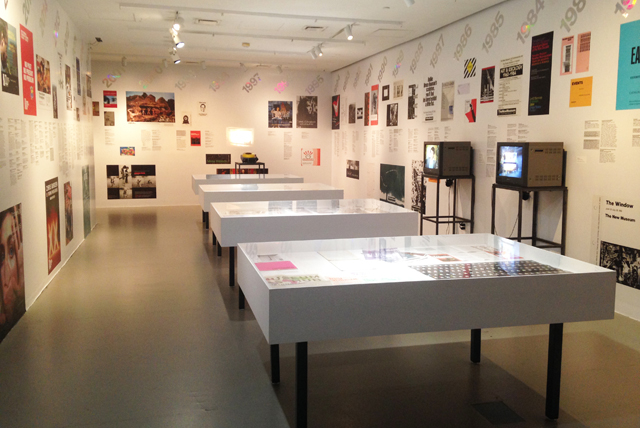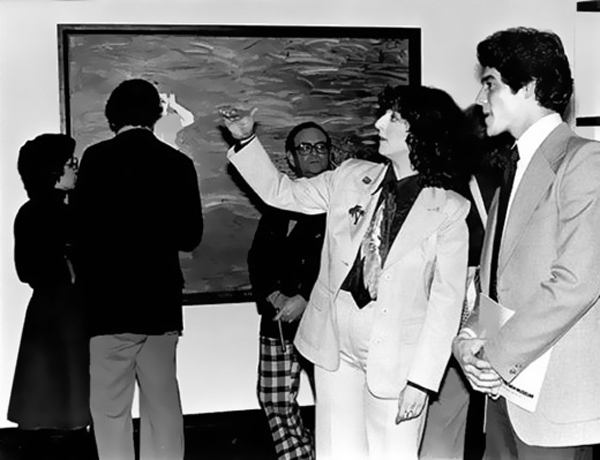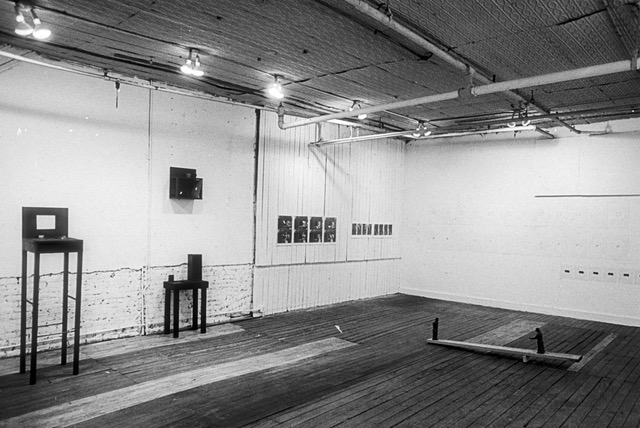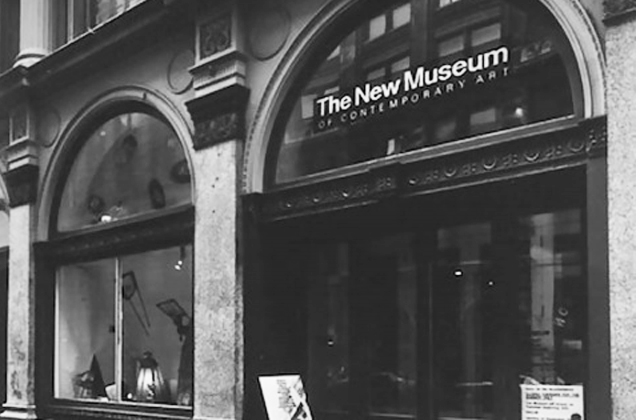Pursuing the Unpredictable
Ron Morosan
December 2017
 Pursuing the Unpredictable, image courtesy of Arteidolia
Pursuing the Unpredictable, image courtesy of Arteidolia
Pursuing the Unpredictable: The New Museum 1977-2017
It is a daunting task to curate and install a forty year archival history of an institution like a museum, yet curator Alicia Ritson, the Marcia Tucker Senior Research Fellow, has done a remarkable job of turning the New Museum’s fifth floor Educational Center into a sprawling installation of posters, wall text, and ephemera that provides the viewer with an immersive experience of viewing the equivalent of a catalogue on the walls. Looking a bit like a display of theatre posters, the show starts on the right as one comes off the elevator with each year of the museum’s history pasted at an angle high up near the ceiling; below are reproductions of archival material and wall text listing exhibitions and events taking place during each year. In the center of the room are four exhibition cases where letters, memos, flyers, and ephemera are displayed. There are two video monitors showing Joan Jonas, Peter Adair videos from the 80’s. At the back of the space a loud clicking sound emanates from a vintage 1990’s Kodak carousel slide projector showing scenes from exhibitions at the 583 Broadway location, the museum’s address before its reincarnation on the Bowery. (However, in this forty year collection one has to keep in mind that this is a selected history, and not all exhibitions and events are listed for each year of the museum’s history.)
In writing this review of the 40th anniversary I must state at the onset that this is more than a review. Since I was involved in the beginning of the New Museum what I write will also be a remembrance and a commentary.
The museum started in January of 1977 in an office Marcia Tucker rented at 105 Hudson Street. The first exhibition titled Memory was held at C-Space, an unofficial alternative space at 81 Walker Street. (I was one of the artists included in this exhibition where I showed installational sculptures that resemble tables and shelves.) The second exhibition was New Work/New York that was held in the Gallery of July and August in Woodstock New York. This was followed by a third show Four Artists’ Drawings held at the Museum of Contemporary Art in Tokyo. Then, through intense efforts, Marcia was able, with the help of art collector Vera List, to secure a large first floor space at 65 Fifth Avenue on the corner of 14th Street. Early Work by Five Contemporary Artists was the first exhibition held in the new space.
 Marcia Tucker at the opening of Bad’ Painting, 1978, New Museum archive
Marcia Tucker at the opening of Bad’ Painting, 1978, New Museum archive
Viewing the installation of Pursuing the Unpredictable requires a lot of attention to details. One needs to pay attention to dates and where each year begins. There are some omissions that leave a gap, like the Double Take exhibition that opened in July of 1978 and was a compilation of the first three museum shows: Memory, New Work/New York, and Four Artists’ Drawings, an exhibition that Marcia re-curated with new work by all the artists. The Double Take exhibition was both a second look at the inaugural exhibitions and a gesture of saying to the artists: “Wow, we actually have a museum now!”
In keeping with her vow to “show artists who were under-recognized or neglected” she secured a retrospective exhibition of the acclaimed painter Alfred Jensen. Long a member of the downtown art scene of the late fifties and early sixties, Jensen was still not well known in official circles of the New York art world. His work was difficult to understand, partially because he developed a concept of painting that was a kind of mystic calendaring with roots in Mesoamerican spiritualism combined with a sophisticated cosmic-geometric number system of his own design.
As one moves along the wall to the left, posters for exhibitions like Invented Landscape stand out for 1979, Ree Morton for 1980, Fashion Moda and John Baldessari for 1981. The names of so many artists and exhibitions cause me to remember the vast number of artists who were introduced into the New York art world and how many radical challenging ideas were confronted.
 Memory: May 10 to 21, 1977, Sarah Canright, Steve Gwon, Ron Morosan, Kent Hines, Earl Ripling,
Memory: May 10 to 21, 1977, Sarah Canright, Steve Gwon, Ron Morosan, Kent Hines, Earl Ripling,
Martin Silverman, Katherine Sokolnikoff, Brenda Goodman, New Museum Archive
In its first decade the New Museum was about inclusion, and Marcia had a wide-open policy of including as many artists as possible, addressing every kind of art being made from all across the country. “The museum as an extension of the artist’s studio” was one of her often used statements. Many shows dealt with art being made in the Midwest and Texas as well as a large contingent from California.
The list of artists who had early career or first major exhibitions at the New Museum is long: Martin Puryear, Allen Ruppersberg, Ana Mendieta, Robert Colescott, Andrea Zittel, Helio Oiticica, Marlene Dumas, Andres Serrano, Mary Heilmann, Elizabeth Peyton, Carrol Dunham, and many others.
In posters and wall texts from the 80’s and 90’s we see how exhibitions of social concern and controversial topics are confronted head-on. Exhibitions with titles like Bad Girls, Fake, Alternatives in Retrospect, Sots Art, and Damaged Goods, would never be on the exhibits list of the Guggenheim, the Whitney, or MOMA. Curator William Olander brought to the museum a willingness to address issues of art made by members of the gay community with exhibitions including Homo-Video and The Art Of Memory/ The Loss of History. The museum dealt with active social issues and when the aids crisis hit, started a program that distributed condoms, and was the earliest museum to participate in A Day Without Art.
In the art scene of the late 1980’s and early 1990’s the New Museum took a lot of critical flak. Word got out that it was a “museum of art and social justice” or that it was not even a museum because it didn’t have a permanent collection. Then in 1994 the performance of Bob Flanagan took place. Curated by Laura Trippi, his performance piece Visiting Hours consisted of bringing his hospital bed into the museum where he would lie while he struggled to stay alive, since he was suffering with cystic fibrosis. Additionally, this show displayed Flanagan’s S&M enjoyment of the struggle; periodically his emaciated naked body would be hoisted up by his heels. This was a screaming: shock! Certainly, no other museum would have hosted this kind of art event. But challenge and risk were the raison-d’etre of the New Museum and nothing artists did was going to be outside of its scope.
In reviewing this display of documentation it is clear that during the entire period of Marcia Tucker’s directorship the New Museum became a social activist institution. Confrontation of issues that were avoided or shunned were taken on without hesitation, whether it was the subject of aging artists in Sustained Visions (unfortunately not on display), or death in Interrupted Life. Feminist and gay issues and civil rights were also addressed. In this sense the New Museum became the forum for art and the body politic.
 Pursuing the Unpredictable, image courtesy of Arteidolia
Pursuing the Unpredictable, image courtesy of Arteidolia
In moving along the installation we see that In 1999 Lisa Philips becomes director and plans for the new building take shape. The late 90’s bring a wider variety of exhibitions including international exhibitions where we see one person shows by Mona Hatoum, Xu Bing, Cildo Meireles, and Doris Salcedo.
This direction becomes more active and in the years after the turn of the new millennium the New Museum becomes a fully International museum. Throughout the 2000’s a host of large scale exhibitions takes place with enormous catalogues for Urs Fischer and Chris Ofili. The museum introduces a Triennial and links up with Rhizome, the art organization dedicated to digital art and culture. With its current exhibition Trigger, Gender as Tool and Weapon, the social concern of the New Museum in the 90’s seems to be back. This show could have been curated by William Olander and Marcia. (online there is an extensive digital archive with most of the 40 year history listed, but there are omissions especially in the first five years.)
Coming to the year 2006 we see that Marcia Tucker dies at her home in California where she taught and lectured. One year later the New Museum opens at it’s new location on Bowery.
In my opinion Marcia Tucker was one of the most original and insightful curators of the post 50’s era. I think her conception of the New Museum was developed out of her own personal approach to life. She was close to being an artist in this sense because she saw the art exhibition as an activist forum that could move into the area of living theatre. This was a component that was conceptual and had connections to Conceptual Art, a movement that was still very important in the late 70’s when the need for alternative ways of thinking about art and its role in society was crucial—a society that was increasingly becoming authoritarian and corporate. I think she felt that a museum had to be flexible and capable of opposing any form of right wing extremism in any form whether it is racism, anti-gay, male dominant, or oppressive of freedom in art in any way. Radicalism was in some sense the theory she pursued. Radicalism in art has a romantic and powerful role to play. It is the dynamic of always questioning the status quo, of being a maverick, of always seeking to see art as a vehicle to explore every aspect of the human social psyche, and to develop new ways of sharing these explorations with the world.
She had a unique capacity to simultaneously think theoretically and pragmatically, socially and aesthetically, politically and culturally, and then also embrace the absurd and the unexpected. She could generate in her personality the qualities of the visual artist, playwright, social philosopher, and actress all at once. I think she would embrace Nietzsche’s statement in Human all Too Human: “Art renders the sight of life bearable by layering over it the gauze of impure thinking.”
As a concept museum the New Museum occupies a position of unique status: on the one hand it is like a work of conceptual museology, questioning the foundation of its own premise for being, but also functioning as a futurist institution where speculation on theories of the museum can take place and new frontiers can open up. Like the “New” in New York City the New Museum may have to continuously re-invent itself. This is a huge task and I think one being well pursued, and hopefully not predictable.
 New Museum, 583 Broadway, 1983-2004, New Museum archive
New Museum, 583 Broadway, 1983-2004, New Museum archive
Pursuing the Unpredictable: The New Museum 1977-2017
The New Museum
235 Bowery
September 27, 2017-January 7, 2018
______________________________________________________________________________________________
Ron Morosan is an artist, writer, and curator. He has shown his work internationally at the American Pavilion of The Venice Biennale and the Circulo De Bellas Artes in Madrid, Spain. In the US he has shown at the New Museum and had a one-person exhibition at the New Jersey State Museum, and at numerous galleries in New York. He curated the Robert Dowd exhibiton, Subversive Pop, at Center Galleries in Detroit, as well as Denotation, Connotation, Implication at Eisner Gallery, City University of New York. He has written catalogues for many artists, including Enid Sanford, Tom Parish, Robert Dowd, and others. In the 1990’s he started and ran B4A Gallery in Soho, New York, writing press releases, articles, and catalogues.
